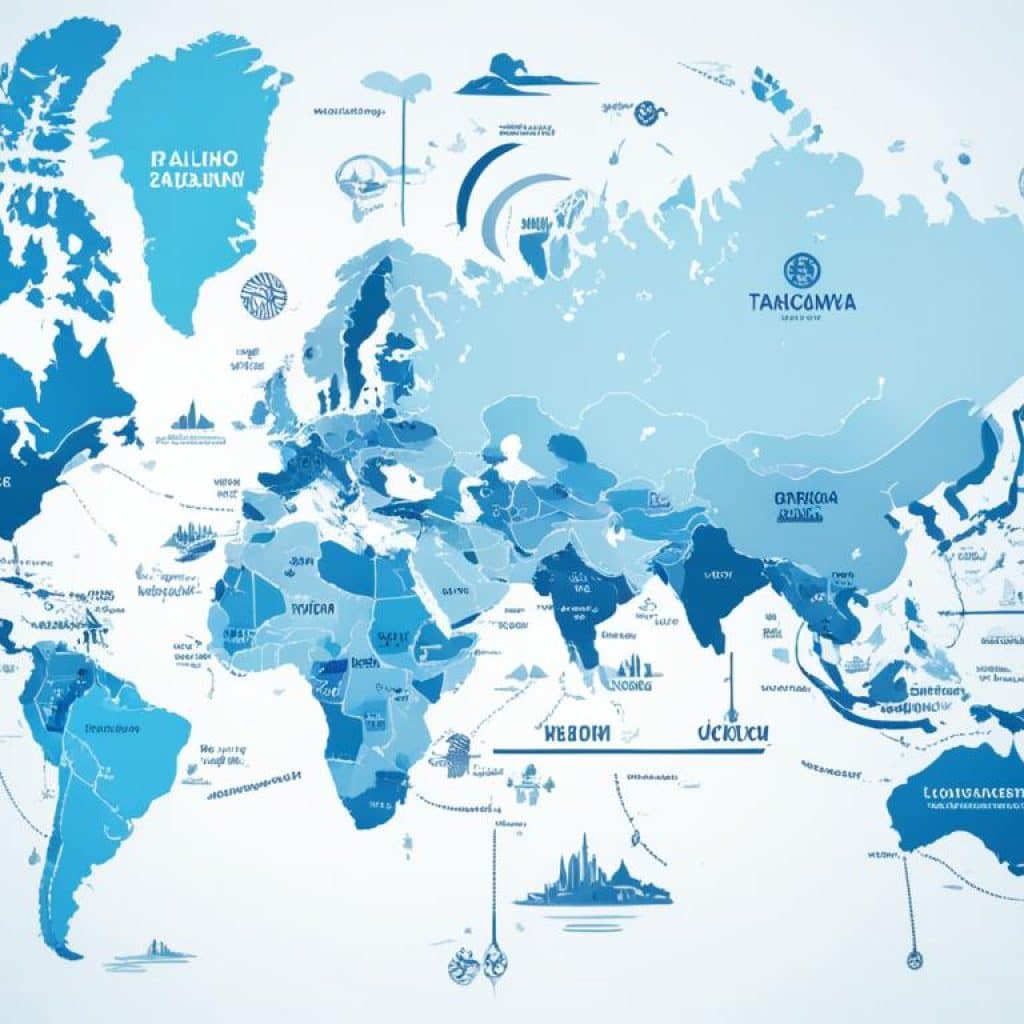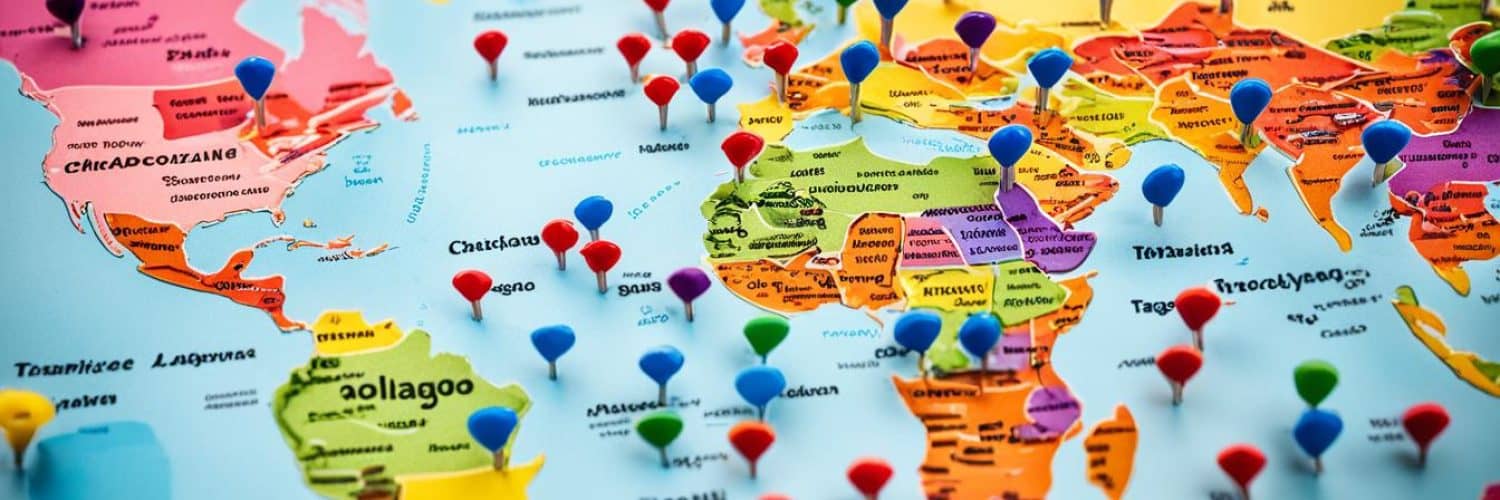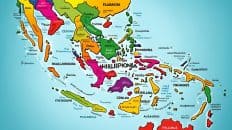Ever wondered about the places where Tagalog is spoken beyond the Philippines? Is its reach only to a few places, or is it found globally? Let’s uncover the places around the world where Tagalog thrives.
Key Takeaways:
- Tagalog ranks among the top languages globally, with 24 million speakers outside the Philippines.
- It’s spoken in countries like Canada, Guam, Saudi Arabia, the United Arab Emirates, the United Kingdom, and the United States.
- This language has absorbed influences from various languages, showing the Philippines’ diverse history.
- Effective communication in Tagalog worldwide needs professional translation services.
- Learning about Tagalog’s origins, variations, and cultural effects helps us understand its global significance and its role in Filipino identity.
The Origins of Tagalog
Tagalog, with a rich history, started in the Philippines more than 1,000 years ago. It has grown under the influence of many countries, like China, Malaysia, Spain, and the USA. These countries have shaped its unique character through their complex histories with the Philippines.
“Tagalog has evolved over time, incorporating words, phrases, and pronunciations from different languages. This blending of influences has contributed to the unique character of the Tagalog language.”
Chinese impact on Tagalog is visible in commerce-related words. Meanwhile, Malay’s influence touches on vocabulary and cultural norms. Spanish rule brought many new words, including those for religion and government. The American era added English words into the mix.
Now, Tagalog is the main language for most in the Philippines. It’s also a second language for many. From it, the Filipino language was formed, which is the nation’s official language.
The Influence of Tagalog History
Exploring Tagalog’s roots sheds light on its growth and the mix of influences it has seen. The cultural and historical interactions have made Tagalog rich and complex.
Knowing Tagalog’s history is key for learners, translators, and speakers. It boosts understanding and helps in connecting with the culture. Tagalog keeps evolving, staying relevant in today’s global scene.
Tagalog Facts and Figures
More than 50 million Filipinos speak Tagalog in the Philippines. It also has about 24 million speakers worldwide. This makes it a widely spoken language globally.
In the United States, Tagalog is very important. It is the third most-spoken non-English language there. Many speakers live in California, Nevada, and Washington. The number of Tagalog speakers in the U.S. is growing. This shows how diverse the country is linguistically.
Tagalog’s history goes back to the 10th century. Since then, it has changed a lot. It has borrowed from many languages. Today, Tagalog is a key part of Filipino culture and heritage.
“Tagalog is more than just a language; it’s a testament to the rich tapestry of Filipino culture and history.”
The Demographics of Tagalog Speaking Population
Let’s look at where Tagalog speakers live around the world:
| Region | Tagalog Speaking Population |
|---|---|
| Philippines | Over 50 million |
| United States | Approximately 1.69 million |
| Canada | Around 90,000 |
| Saudi Arabia | Over 50,000 |
| United Arab Emirates | Approximately 40,000 |
| United Kingdom | Around 30,000 |
The numbers show Tagalog’s global importance. It is key for communication and cultural identity for millions.
As Tagalog becomes more popular, translation services are crucial. They help overcome language barriers. This ensures clear and culturally respectful communication with Tagalog speakers everywhere.
Tagalog in the United States
The United States has a large and active Tagalog-speaking community. About 1.69 million people speak the language. Most live in California, Nevada, and Washington. These places have strong Filipino communities that add to their richness.
In the US, Tagalog is an important language. Schools and universities teach it to keep up with the demand. These courses help Tagalog-speaking students and their families.
Tagalog’s impact is seen in entertainment too. For example, Black Eyed Peas’s apl.de.ap and Meghan Markle speak it. This shows the language’s popularity in culture.
To see where Tagalog speakers live in the US, look at the table below:
| State | Number of Tagalog Speakers |
|---|---|
| California | 1,101,000 |
| Nevada | 152,000 |
| Washington | 118,000 |
| Texas | 105,000 |
| New York | 89,000 |

The Filipino community in the US is growing. Tagalog is becoming more important. It’s used for talking, connecting to roots, and bridging communities.
Tagalog Translation Services
Communicating with Tagalog-speaking audiences effectively needs professional translation services. Tagalog’s worldwide influence demands precise and culturally sensitive translations. This connects businesses and people with their audience. Here’s where Dynamic Language steps in.
Dynamic Language has over 30 years of experience in language translation services, including Tagalog. Our team has native-speaking translators. They understand the language and culture’s subtleties. This ensures your message is accurate and impactful.
“Choosing professional Tagalog translation services like Dynamic Language ensures that your content resonates with Tagalog-speaking audiences, making a lasting impression and helping you achieve your communication goals.”
If you need Tagalog translation for business documents, marketing materials, websites, or other content, our team is here to help. We focus on translating your message accurately while minding cultural sensitivities.
Why Choose Dynamic Language for Tagalog Translation?
- Accuracy: Our native-speaking translators are experts in Tagalog. They ensure your translations are precise.
- Cultural Sensitivity: We know how crucial cultural context is in translation. We make your content appropriate and relatable for Tagalog speakers.
- Industry Expertise: With experience in various sectors, Dynamic Language can handle translations for any industry.
- Quality Assurance: Our thorough QA process guarantees high-quality translations. This gives you confidence in our work.
- Timely Delivery: Meeting deadlines is crucial for us. Dynamic Language commits to timely delivery, every time.
Trust Dynamic Language for unmatched Tagalog translation services. Let us assist you in connecting with your Tagalog-speaking audience for a memorable impact.
The Importance of Accuracy in Tagalog Translation
Translating into Tagalog must be accurate. Basic tools like Google Translate sometimes miss the mark due to dialect differences. This highlights the importance of professional Tagalog translators. They are native speakers who understand these nuances.
In important documents or marketing, getting translations right is crucial. Mistakes can lead to confusion or harm a company’s image. Using professional translators ensures messages are correctly conveyed to Tagalog-speaking audiences.
Professional Tagalog translators grasp the language’s subtleties and cultural contexts. They know the dialects well. Their work ensures translations are appropriate for the target region or community. This skill goes beyond what automated tools can achieve.
“Accurate translation captures the text’s essence and intent. Professional Tagalog translators combine language skills with cultural knowledge to maintain the original content’s integrity.”
Experts in Tagalog translation also understand industry-specific terms. Whether it’s legal, medical, or marketing language, they ensure the translations are precise. This expertise is invaluable across various industries.
Investing in professional Tagalog translation avoids missteps and misunderstandings. It allows businesses to reach Tagalog-speaking markets effectively. This expands their global footprint.
Benefits of Professional Tagalog Translators
Professional Tagalog translators offer key advantages:
- Accurate translations: They ensure translations reflect the original text’s meaning and intent accurately.
- Cultural sensitivity: Being native speakers, they grasp cultural subtleties, ensuring messages resonate with the audience.
- Industry expertise: Their familiarity with specific fields allows them to handle specialized terminology effectively.
- Efficiency: They meet deadlines while maintaining high-quality standards.
- Confidentiality: Translators keep sensitive information private throughout the translation process.
Choose Professional Tagalog Translation Services
For reliable Tagalog translations, partner with agencies like Dynamic Language. They have experienced native-speaking translators. Dynamic Language offers accurate, culturally sensitive translations, drawing on over 30 years in the industry. They are a trusted source for professional Tagalog translation services.
Don’t risk your translations. Rely on professional Tagalog translators to connect with your Tagalog-speaking audience accurately.
Tagalog Dialects and Variations
Tagalog is a common language in the Philippines, with many dialects and regional forms. These variations have evolved, shaping how Tagalog is spoken across the country. Here, we’ll look at some key Tagalog dialects:
- Bataan
- Batangas
- Bulacan
- Lubang
- Manila
- Marinduque
- Puray
- Tanay-Paete
- Tayabas
Though these dialects might vary in vocabulary, pronunciation, and grammar, they are usually easy to understand between speakers. Understanding these differences is key in translating or communicating in Tagalog effectively.

For example, people speaking Tagalog in Bulacan may use unique words or phrases unlike those in Marinduque. Also, how they pronounce words and their grammar can slightly change between regions.
Even with these differences, all Tagalog dialects are part of the language’s rich fabric. They show the diversity of the Filipino people and their regional identities.
Knowing the different dialects is important. It helps in making accurate, culturally aware translations. And it makes communicating with Tagalog speakers from various areas more effective.
Taglish: The Combination of Tagalog and English
Taglish is a blend of Tagalog and English. It is often spoken and written by many Filipinos, especially younger people. They find it easier and more natural to use Taglish. It’s widely accepted in the Philippines and shows how diverse the culture is there.
When people use Taglish, they switch between Tagalog and English smoothly. This way, they can share their thoughts using words from both languages. This shows the versatility of Filipinos in language and highlights their rich culture.
“Taglish is like a reflection of our society and a testament to our ability to adapt and evolve. It bridges the gap between the traditional and the modern, showcasing our rich cultural heritage while embracing the influence of the English language.”
– Dr. Marie Cruz, Linguistics Professor at the University of the Philippines
Taglish isn’t just for casual talks. It’s also seen in movies, TV shows, and music. Filipino artists often use Taglish, connecting with people of different ages and backgrounds.
This mix of Tagalog and English may seem strange to some. But it shows how languages can change and grow. Taglish helps Filipinos keep their identity while also accepting English. It’s all about being flexible and creative in how we communicate.
Taglish: A Linguistic Blend
The key features of Taglish include:
- **Code-switching**: Taglish involves smoothly switching between Tagalog and English within the same conversation or sentence, creating a unique linguistic blend.
- **Vocabulary mix**: Taglish incorporates vocabulary from both Tagalog and English, resulting in a rich and diverse linguistic repertoire.
- **Grammar fusion**: Taglish combines Tagalog and English grammar rules, resulting in a hybrid grammatical structure.
- **Sociolinguistic variation**: The use of Taglish varies across different social contexts, with speakers adapting their language based on factors such as age, education, and regional influences.
Taglish is a linguistic phenomenon that reflects the sociocultural landscape of the Philippines. It highlights the adaptive nature of language and the dynamic ways in which Filipinos communicate and express themselves.
| Benefits of Taglish | Challenges of Taglish |
|---|---|
|
Tagalog Literature and Cultural Influence
Tagalog literature is vital to Filipino culture. It shows the rich stories, values, and traditions of the Filipino people. One key work, the epic poem “Florante at Laura” by Francisco Balagtas, highlights the beauty of the Tagalog language. It tells a story of love, bravery, and resilience.
Tagalog literature helps shape the Philippines’ cultural scene. It lets us see into the Filipino soul and highlights their identity. Tagalog stories often talk about love, nationalism, family, and societal matters. These themes deeply connect with readers.
Tagalog songs, movies, and TV shows deeply influence Philippine culture and beyond. Tagalog music or “OPM” has touching lyrics about love, patriotism, and life. These songs bring Filipinos together, creating strong bonds.
Tagalog movies and TV, or “Filipino cinema” and “teleserye,” are known worldwide for their unique stories and great acting. They entertain and show Filipino culture, traditions, and social concerns.
Tagalog arts and media have greatly influenced culture, both in the Philippines and globally. They connect Filipinos everywhere, keeping their culture alive. This boosts unity and pride among them.
The Influence of Tagalog in Various Art Forms
Tagalog’s reach goes beyond texts and media. It also impacts various art forms like visual arts, theater, dance, and fashion.
- Visual Arts: Filipino artists often draw from Tagalog culture, using it in their art. Their work showcases Tagalog identity, enriching the Philippines’ art scene.
- Theater and Dance: World stages feature traditional Tagalog dances, highlighting Filipino culture’s beauty. Tagalog theater tells captivating stories through powerful acting.
- Fashion: Tagalog-inspired fashion is recognized globally for its bold colors and patterns. Filipino designers use Tagalog themes in their work, showing off Filipino pride and identity.
Tagalog culture’s influence is widespread and keeps growing. It plays a big part in the world’s diverse cultural scene. This fosters understanding and appreciation across cultures.
The Cultural Significance of Tagalog Literature
Tagalog literature does more than entertain. It keeps Filipino culture alive for future generations. It’s a way to pass down Filipino values and traditions.
| Benefits of Tagalog Literature | Cultural Impact |
|---|---|
| Preserves Filipino cultural heritage | Strengthens national identity |
| Provides insights into Filipino history | Promotes cross-cultural understanding |
| Explores universal themes with a Filipino perspective | Inspires creativity and artistic expression |
Tagalog literature boosts Filipino pride and identity. It’s a key way to share Filipino experiences and foster dialogue, understanding, and unity.
Tagalog as an Official Language
Tagalog is the native language of the Philippines and is very important to its culture. It became the official language in 1879. Later, it was replaced by Spanish as the official language. By 1935, English and Spanish were named the official languages. There was also a push to create a national language from a native one.
In 1987, Tagalog got a new name, Filipino, and became the official national language alongside English. This move highlighted Tagalog’s importance in the Philippines’ culture and communication. It shows how deeply Tagalog is woven into the Filipino identity.
Making Tagalog the national language aimed to bring the Philippine’s diverse people together. It wanted everyone to understand each other, no matter where they were from. This was about making sure all Filipinos could communicate easily.
Tagalog in Education
Tagalog is important in the Philippines’ education system. It’s taught in schools along with English. The Department of Education has set up a system where students learn in their first language, including Tagalog. This aims to make learning better and keep native languages alive.
Language of Instruction
In Philippine schools, Tagalog is a main teaching language. It helps students grasp concepts in a language they know well. Teachers can explain things more clearly in Tagalog. This leads to a stronger grasp of the subjects. English is also taught, making students proficient in both.
Mother Tongue-Based Multilingual Education
The Department of Education wants to save native languages and culture. They have started education in the student’s first language, like Tagalog. In early education, this is the focus. Later, Filipino and English are added. This helps students as they move forward in school.
“The mother tongue-based multilingual education system connects students to their culture. It helps them learn and speak up more confidently. This leads to better grades and keeps cultures alive.” – Department of Education
Benefits of the Mother Tongue-Based Approach
The mother tongue-based education system has many advantages:
- It boosts brain development. Learning in a known language improves thinking skills and solving problems.
- It makes communication better. Students get good at sharing ideas and having deep talks.
- It keeps culture alive. Students appreciate their heritage and traditions more.
- It gets parents more involved. They can help and support their child’s learning more.
This approach leads to better school performance and keeps the country’s languages and cultures vibrant.
| Language of Instruction | Mother Tongue-Based Multilingual Education |
|---|---|
| Tagalog is used as the language of instruction in schools. | Instruction is conducted primarily in a student’s mother tongue, including Tagalog. |
| English is taught as a second language. | Other languages, including Filipino and English, are gradually introduced as students progress. |
| Clearer explanations and better understanding of concepts. | Enhanced cognitive development and improved communication skills. |
| – | Cultural preservation and increased parental involvement. |
Tagalog and Identity
The Tagalog language is closely tied to Filipino identity. It helps people feel connected to their heritage and fellow Filipinos. This language is filled with cultural values and traditions. It is a key part of the Philippines’ cultural diversity.
Tagalog also helps shape who people are, both as individuals and as a community.
The Importance of Cultural Identity
Cultural identity shapes how we see ourselves. It includes the values, beliefs, and traditions of a group. For Filipinos, Tagalog is a big part of this identity.
Tagalog is a symbol of their heritage and brings Filipinos together. It allows them to share their thoughts and stories. By keeping Tagalog alive, they keep their cultural identity strong.
“Language is the key that unlocks the door to another culture. By speaking Tagalog, Filipinos can reconnect with their roots and heritage, fostering a deeper understanding of who they are.”
The Role of Tagalog in Cultural Preservation
Tagalog is vital in keeping Filipino culture alive. It helps pass down customs and values. Tagalog is a way to share folklore and stories that show the Filipino way of life.
This link between language and identity affects many parts of Filipino society. Arts like music and dance often use Tagalog. Even festivals, such as Sinulog in Cebu, highlight Tagalog’s importance.
Tagalog and National Identity
Tagalog’s role as the national language underscores its value. Known as Filipino, it’s used in government, schools, and media. This cements its role in developing a shared national identity.
| Tagalog and Identity | Highlights |
|---|---|
| Unifying Language | Tagalog connects Filipinos and fosters a sense of unity and belonging. |
| Cultural Preservation | Tagalog plays a crucial role in preserving Filipino customs, traditions, and values. |
| National Language | Tagalog, as the national language, solidifies its place in shaping the collective national identity of Filipinos. |
Embracing Tagalog in the Global Community
As Filipinos move around the world, keeping Tagalog alive is important. It makes them feel connected to their roots. It also lets them share their culture with others.
By holding onto Tagalog, Filipinos add to the world’s cultural diversity.
Conclusion
Tagalog is spoken around the world, with roots in the Philippines. It has reached countries like the United States. This language is a big part of Filipino culture and history.
For those speaking Tagalog, professional translation is key. It helps share ideas clearly and respects cultural differences.
Understanding Tagalog’s background and influence helps us value it more. It’s the third most spoken non-English language in the U.S. With 24 million speakers globally, Tagalog brings people together across cultures. Tagalog’s deep roots and importance in Filipino culture make it a language to learn and value.







Add comment